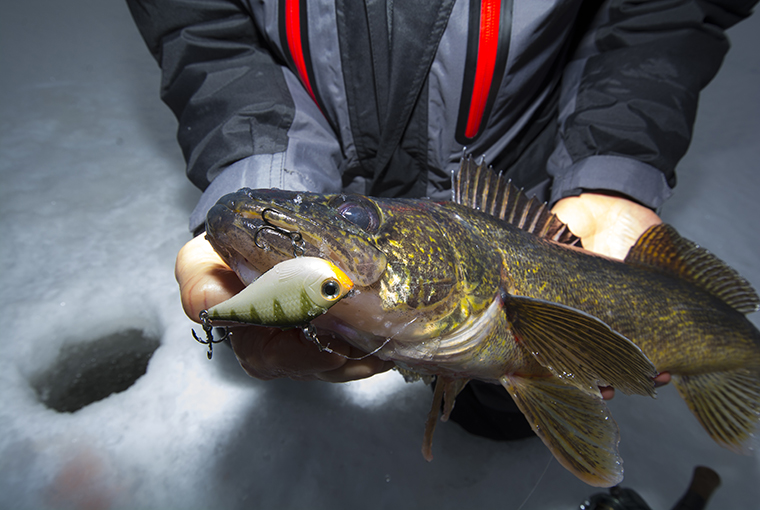
Many factors influence fish behaviour. We know water temperature plays a major role, but a lake’s winter temperatures will only fluctuate a few degrees, if that. This prompts the question, what’s the next most-critical factor affecting fish beneath the ice?
In my experience, the answer is food. This might not be earth-shattering news, but consider that predatory fish evolved to assess hunting opportunities based on the potential energy gained versus lost when choosing whether or not to pursue prey. The closer a predator stays to its food, the more chances there are to eat meals requiring minimal effort, conserve energy, and, thus, reduce the risk of incurring a caloric deficit. This strategy is especially vital during winter’s harsh conditions, which for many species soon leads into the stress of a spring spawn.
For anglers, keeping the predator-prey relationship in mind can help find fish faster and catch more of them. This approach has served me well for bluegills, crappie, perch, rainbow trout, walleye, northern pike, whitefish, you name it. Here’s a look at some common food sources for these species, and how understanding what predators are eating can help decide where to fish and presentations likely to yield the best results.
Crappie and bluegills forage phytoplankton and zooplankton
Phytoplankton are microscopic plants. Zooplankton are teeny creatures that eat phytoplankton and, in some cases, each other. I’m not a scientist, but I can tell zooplankton impact the feeding activity of crappie, bluegills, and other fish. If you’ve ever fished a spot for hours in the afternoon with minimal success, only to find yourself in the middle of a panfish stampede around sunset, zooplankton probably played a role. Certain zooplankton get active around sunrise, sunset, and at night. During these periods, hoards of zooplankton rise from bottom to feed.
Bluegills and crappie are very efficient at eating zooplankton. They swim through the soup with mouths agape, filter-feeding their way to a full belly. The smorgasbord attracts other creatures, too, including freshwater shrimp and baitfish. This means more food options for panfish, but can also attract walleye, pike, and other larger predators.
Zooplankton can be found in many places. Soft-bottom areas are reliable locations. Mud and sand flats are also good. The sticky bottom zone at the base of a steep drop-off is another prime spot, especially when beside a healthy weed bed.
How to fish: When panfish are filter feeding, finesse tactics are the way to go. I do best with tiny ice jigs tipped with a scented soft-bait or a few live maggots. These are worked with short, slow arm raises, as well as drops and hops. Hard shakes can attract fish from afar, but generally less is best for triggering strikes from neutral fish once they get closer. Aggressive fish, however, may find hard quivers irresistible, so experiment and see what works best.
When panfish are actively feeding and competitive with each other, jigging spoons and other lures can be effective. And when the stars align, upsizing stimulates strikes from bigger fish.
Useful tool: The last few seasons, I’ve found Cold Snap Outdoors’ T2 Toothpick Hook Remover an excellent tool for getting tiny ice jigs out of panfish. Put the Toothpick’s notch on the hook bend and push it out. Easy peasy. Tools operating on a similar principle can sometimes be found in fly fishing shops.
Perch, crappie, trout, and whitefish forage bloodworms
The larvae of midge flies are another food source for multiple species. These invertebrates can have a bright red colouration, hence, the name. I’ve also seen them be brown and olive. Bloodworms are found in muddy-bottom areas, living in little tubes they make and call home. Perch are notorious for wandering mud flats grazing on bloodworms. They move along unhurried and are often uninterested in most lures when so much free food is right under their noses.
How to fish: My preferred presentations for catching bloodworm-eating perch are a tiny ice jig tipped with a couple real maggots, some Berkley Gulp! Alive! Maggots, or an ultra-thin, wispy-tailed plastic worm. Red, purple, and glow pink plastics work well.
When panfish are filter-feeding on zooplankton, I use small jigs tipped with scented soft baits or live maggots.
These baits should be fished very tight to bottom with a less-is-more approach. Lightly tapping the jig on bottom can attract fish and trigger occasional bites. As will moving the rod tip from one side of the hole to the other to drag the jig across the floor. Dead-sticking the bait on bottom on a tight line works when perch are ultra fussy.
Perch, crappie, bluegills, trout, and whitefish forage freshwater shrimp (scuds)
Shrimp feed on zooplankton and, as a result, often end up in the stomachs of filter-feed-ing crappie and bluegills. Perch, trout, and whitefish also eat these tiny crustaceans.
I’ve caught panfish feeding on scuds suspending 10 feet below the surface along a 10-to-16-foot drop-off into deep water. Shallow to mid-depth sand and mud flats are also productive locales.
Healthy vegetation is also important shrimp habitat. I’ve had scuds fall off of a strip of vegetation I was removing from my lure. If this ever happens to you, take a scud, put it in the water and watch how it swims to get an idea of the type of movement to replicate when jigging.
How to fish: Given a scud can fit on a thumbnail, small jigs tipped with maggots or finesse plastics often prove effective. You can also get creative with different jig and soft-plastic combos to make a scud replica. A nymph-profiled plastic (see below) can also be a close enough replica to trigger bites.
Micro tube jigs are also potent. A 1/32-ounce, pearl white Berkley PowerBait Atomic Teaser (tail removed) has caught me plenty of scud-eating panfish over the years.
Using a light jig helps replicate a scud’s awkward swimming action and slow sink rate. Think “two steps forward, one step back” when using shakes, lifts, and drops to manipulate a jig because fresh-water shrimp don’t swim with the same grace as minnows.
Impersonating a scud with a dainty jig is not always required, though. I’ve used spoons, Rapala Jigging Raps and darters/lipless crankbaits to catch fish that spit up scuds. Whether fish want a scud lookalike or are willing to hit a lure depends on many things, but their activity level and competition for food among the pack are two examples.
Panfish, walleye, whitefish, burbot, and pike forage crayfish
Crayfish live along rock and gravel areas on the lakebed. Nicknamed “mudbugs,” expect to find craws inhabiting soft bottom regions. Cabbage, milfoil and sand grass (aka chara) are also impor- tant habitat for crayfish.
How to fish: When up against fussy fish, using a realistic crayfish imitation is wise. Northland’s pre-rigged 11 ⁄ 2” craw on a 1 ⁄ 16 -ounce jig has helped me sight-fish perch munching on mudbugs.
Mister Twister’s Micro Crawfish is another one panfish can’t resist. Tube jigs are also reliable craw imposters.
Banging bottom with a bait attracts fish and stimulates feeding. The impact creates a silt cloud, or makes noise on rock. Fish focused on crayfish aren’t nibbling on dinner-mint size prey, like the forage species discussed above.When fish are actively feeding on craws there’s more opportunity to fool them with a variety of lures. You can get bites on a bare lure, but it doesn’t hurt to add some live bait or a scented soft bait.
The stomach contents of a burbot
Burbot crayfish OOD contributor Jeff Gustafson catches a lot of burbot from Lake of the Woods and other lakes in Sunset Country from late February and through March. His best bait all time is a 1 ⁄2 oz Northland Buck-Shot Rattle Spoon tipped with a couple of minnow heads or a shiner on the treble hook.
Tip-ups and other stationary presentations with a minnow hooked on a jig close to bottom also work.
It appears burbot aren’t picky about the type of meat they eat. As Gustafson explains:
“Most of the fish that we clean have bellies full of crayfish, as well as rocks, which they must swallow while sucking up the crayfish.”
All water is not equal
Fish will eat a variety of things throughout winter, and forage can vary significantly from one lake to the next. What tends to be universal, however, is that unproductive ice fishing areas are typically either void of food or pale in comparison with other locations providing foraging opportunities.
Trout, panfish, and walleye forage nymphs
I haven’t seen nymphs scurrying on bottom, but I have my suspicions mayfly nymphs were in the stomachs of many fish I’ve cleaned over the years. These buggy baits get bit. You’re likely to find fish feeding on nymphs in similar places as scuds and crayfish. Bays and flats leading into reedy shorelines are also good locales. Invertebrates also like sunken timber, so don’t overlook this stuff either.
How to fish: Last February, a Z-Man 1.75-inch LarvaZ (an invertebrate imitation with bulging eyes, wispy legs, and a thin, segmented tail) was a hot bait for fooling perch, crappie, and bluegills from a shallow, soft-bottom, river backwater area. Berkley’s one-inch PowerBait Power Nymph is another bait I’ve used to make fish come unglued. Mister Twister’s Nymph is another good pick.
The jigging tactics described for scuds and crayfish are pretty much how I fish using nymph baits. Generally, less action is better.
All sport species forage fish
Minnows, suckers, ciscoe, shiners, rainbow smelt, yellow perch, and other species represent another big “food group.” Here are some broad patterns related to predators feeding on baitfish.
One detail anglers should determine is whether baitfish are on bottom or suspended. This informs the depth range to work your lure. For example, when fishing a system containing gobies, you are likely to encounter a lot of down-feeding perch, lake trout, walleye, and whitefish. Gobies don’t have an air bladder and are confined to the lakebed. They dart around a lot, which makes hops and snaps effective when working lures or jigs. Tapping a bait on bottom is a good idea.
These maneuvers aren’t just for fooling goby eaters. Try them when perch, sculpin and other baitfish are tight to bottom.
The other major scenario anglers face is dealing with nomadic schooling fish, such as rainbow smelt or ciscoe. When pelagic baitfish dominate the menu, anglers catch lake trout, walleye and pike around main basin features, such as offshore humps, deep bars, secondary points, islands, and bluff walls. Predators use these structures to conceal themselves before launching an attack as well as for corralling and trapping baitfish.
Electronics play a huge role in angling success when schooling baitfish are the predominant forage. Don’t fish until your sonar displays pods of baitfish and, ideally, some larger predators.
Similar types of lures can be used for catching fish in either scenario. Good options include jigging spoons, Rapala Jigging Raps, lipless crankbaits, tube jigs, and swimbaits or flukes on jigs. Large jigging strokes attract fish from afar. Shorter lifts of varying intensity, shakes, and controlled raises and lowering of a bait are foundational jigging strokes for triggering bites. Tailor moves based on the prey. A walleye eating gobies is likely to have a limit to how far it will rise off bottom to chase a bait. On the other hand, a lake trout feeding on smelt may be willing to pursue a tube jig raised 25 feet or more.
As discussed previously, playing cat-and-mouse with a predator is effective at triggering strikes.
Use sonar to help position the lure just out of the reach of the fish and keep them chasing. Dead-sticking might work on occasion for fussy fish, but an aggressive predator can quickly lose interest when capturing prey becomes too easy. This is especially true on waters with heavy angling pressure. Matching lure colour to resemble the abundant baitfish. Natural browns and olives are good for gobies. Using a lure with a barred paint job can make a big difference when walleye and lake trout are eating perch. Jumbos can also be cannibalistic. Golden shiners on the menu? Use a golden spoon. You get the picture.
Learn what the fish are eating. Replicating what’s on the menu is critical in persuading them to strike.
Originally published in the Nov.-Dec. 2023 issue of Ontario OUT of DOORS


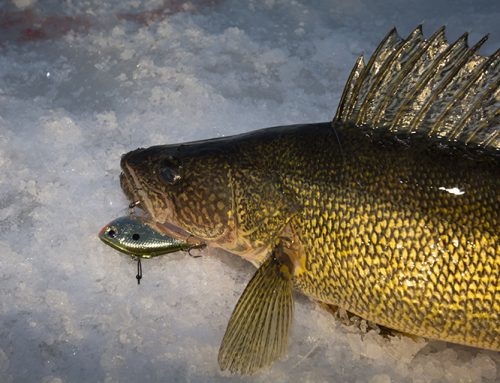
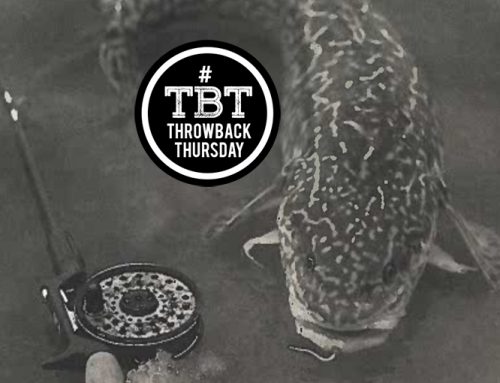
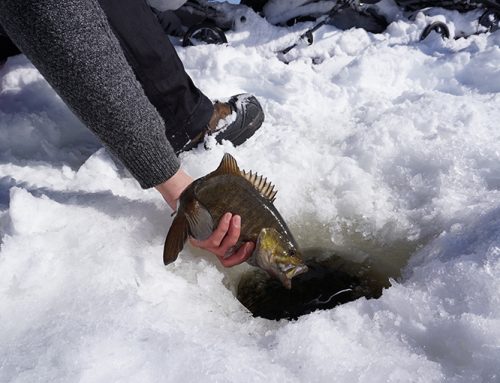
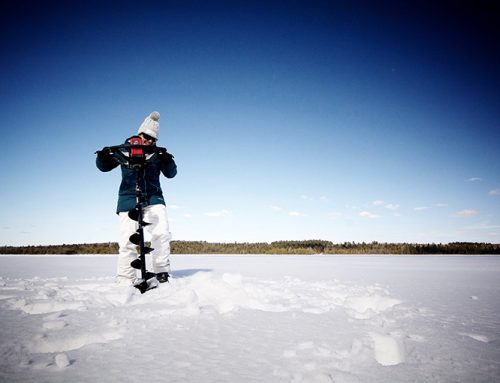
Leave A Comment